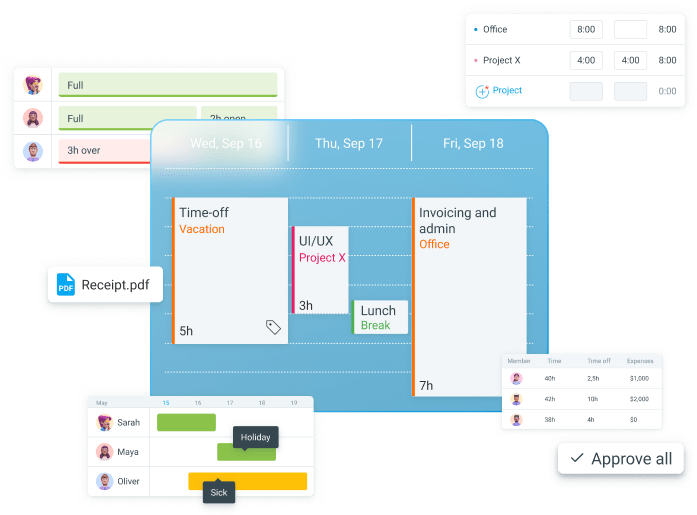If you’re a small business owner or an operations manager, you likely have a ton on your plate — competing goals and deadlines, budgets, scheduling, and more.
On top of that, you have to track your employees’ productivity and attendance.
Solution? You need a dedicated clock-in clock-out system to make things run smoothly.
We’ll explain the benefits of clocking in and out and how you can set up a clock-in clock-out system to track employee working hours effectively.

Table of Contents
What does clocking in and out mean?
Clocking in is when employees record the exact time they arrive at work or start their work shift. Conversely, clocking out is the act of recording the time employees finish their work shift.
By clocking in and out, employees track their actual hours worked, enabling operations managers to:
- Get the necessary data for accurate payroll,
- Comply with labor laws,
- Measure employee productivity, and
- Monitor employee attendance and absenteeism.
💡 CLOCKIFY PRO TIP
To discover how you can reduce absenteeism in the workplace, read the following blog post:
What is a clock-in clock-out system?
A clock-in clock-out system is a tool designed to help business owners and operations managers track their employees’ work hours and attendance.
For instance, employees can record their start and end work times by entering them manually in paper timesheets. If they use an online clock-in system, like a timer app, they can record their work hours by starting/stopping the timer once they begin/finish their workday.
Using a clock-in clock-out system to track employee working hours, including overtime, ensures accurate overtime calculations and fair employee compensation. That said, a lack of a proper clock-in/out system leads to many issues, including:
- Inaccurate payroll processing,
- Potential labor law violations,
- Decreased accountability,
- Increased time theft, and
- Inefficient and incorrect tracking of breaks and hours worked, especially for remote and field-based employees.
In other words, using a proper clock-in/out system is crucial for employers as it helps them better manage overtime costs, streamline payroll, and simplify compliance.
How to set up a clock-in clock-out system in 5 easy steps
To set up a clock-in clock-out system for effective employee time tracking, you need to:
- Find the most suitable time and attendance system for your business,
- Develop a clear clock-in clock-out policy,
- Offer incentives for accurate timekeeping,
- Track breaks, and
- Analyze the clocking data to identify patterns and address performance issues.
Let’s discuss each in more detail.
#1: Find the most suitable time and attendance system
When looking for the right clock-in/out system for your business, consider the following factors:
- Usability — make sure your time and attendance system is easy to use. Choosing a user-friendly system saves both you and your employees a lot of time and makes adaptation smoother, increasing overall efficiency.
- Key features — if you’re a small business owner with a few employees, you may only need basic time tracking. In contrast, larger businesses may require advanced features, such as robust reporting and scheduling. Also, companies with field employees may need GPS tracking to ensure accurate record-keeping.
- Integration with payroll software — being able to integrate your timekeeping system with your payroll software is always a plus, as it automates data transfer and reduces the administrative burden on your payroll department.
Of course, a clock-in/out system should also fit your budget, so assess your needs and available budget, and choose a solution that satisfies both.
#2: Develop a clear clock-in clock-out policy
Having a clear clocking-in and out policy is essential for managing employee attendance. It helps your employees understand why they need to clock in and out and how to do it, allowing you to properly track employee time and attendance and avoid potential legal issues.
A well-crafted clock-in/out policy includes:
- A short explanation of the policy’s purpose,
- Your expectations regarding when employees should clock in and out (at the start/end of the shift),
- Detailed instructions on how to use the clock-in clock-out system,
- Protocols for missed clock-ins or errors, and
- Consequences for policy violations (in cases of buddy punching or time theft).
Once you create a clock-in/out policy, make sure it’s available to all employees by including it in the employee handbook or posting it on the company’s website for easy access.
💡 CLOCKIFY PRO TIP
If you need additional advice on how to prevent employees from not clocking in and out, read the resource below:
#3: Offer incentives for accurate timekeeping
To encourage the consistent use of the clock-in clock-out system, consider offering incentives to your employees, like:
- Extra paid time off,
- Small bonuses, or
- Gift boxes that motivate employees to follow timekeeping procedures.
This, in turn, helps you ensure accurate payroll and compliance.
Moreover, you can divide your employees into teams and organize a friendly competition for a group award. For instance, you can award the team with the highest number of perfect attendance days at the end of each month.
This will help boost team spirit and enhance employee accountability.
#4: Track breaks with a clock-in/out system
The main point of setting up a clock-in clock-out system is to gather information on when your employees start and finish their workdays.
While this does give you an insight into who is frequently late or leaves work early, that’s not the full picture.
For instance, some employees tend to prolong their breaks without your knowledge. This is a form of time theft that not only leads to monetary loss but is also unfair to other employees who are productive during their entire shift.
According to 2025 statistics on employee theft, 54% of employees in the US perform personal tasks while on the clock.
You can solve the issue of time theft with an adequate time clock app. Time clock apps like Clockify allow you and your team members to account for breaks in 3 ways:
- Enable the breaks feature, and employees will then have the Start break option when they open the kiosk.
- Have a break project so workers can create separate time entries for their breaks and associate them with the break project.
- Create a break tag so employees can create a time entry and attach the break tag. Later, you can group time by tag or filter it out from work time.
Finally, you can differentiate between work and break time in reports — and filter them either by project, tag, or status.
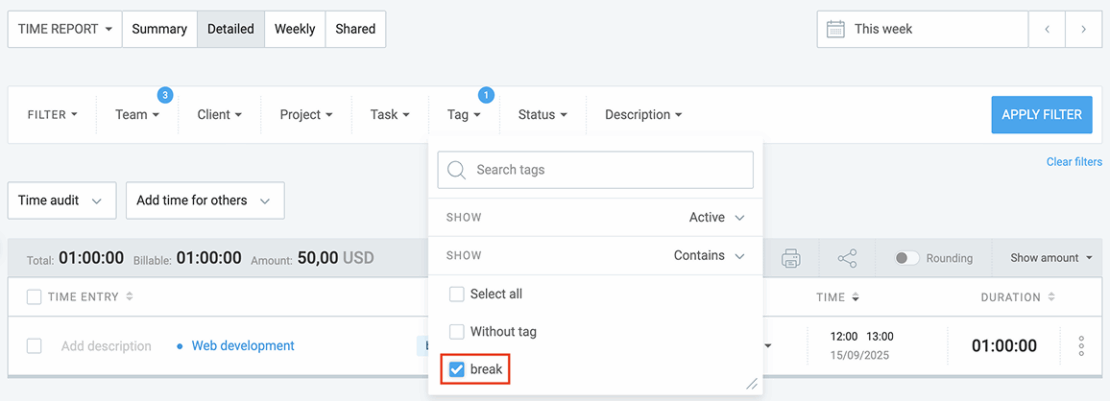
#5: Use a clock-in/out system to analyze clocking data
Clock-in and clock-out reporting is critical for accurately tracking employee work hours, as it provides a comprehensive overview of when employees clocked in and out, along with other relevant details.
With a time clock app, such as Clockify, you can easily check your team’s attendance by using attendance reports. These reports show your employees’ daily:
- Start and end times,
- Total break hours,
- Total work hours,
- Capacity,
- Overtime (that is, the difference between hours worked and set capacity), and
- Time off.
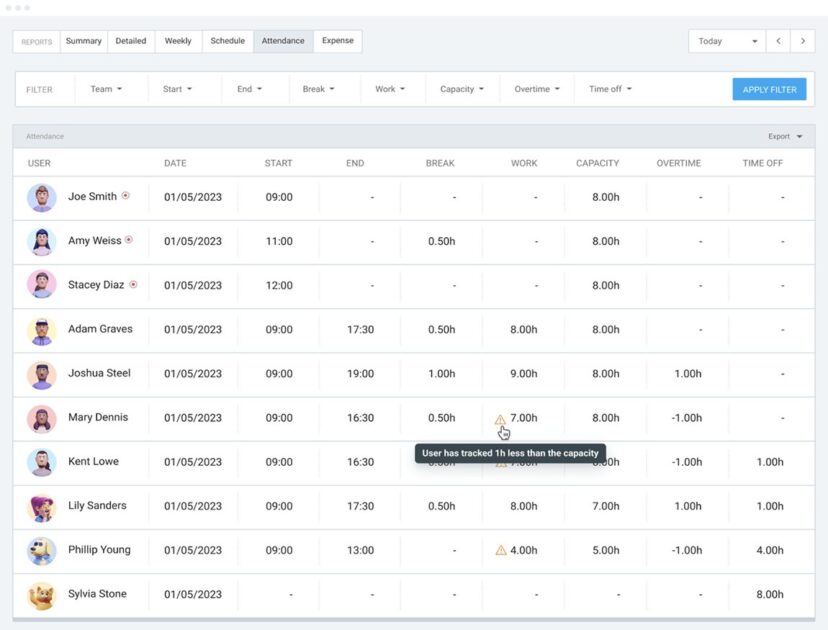
You can also use filters and different date ranges to answer specific questions — from who had overtime on which days to who started working before 9 a.m.
All this data can help workforce management learn who is working too much and who is underperforming. In turn, employees will be able to stay productive and healthy.
Moreover, Clockify provides real-time GPS location tracking. This option allows you to see locations where people record their start and end times — as well as the route they traveled while clocked in.
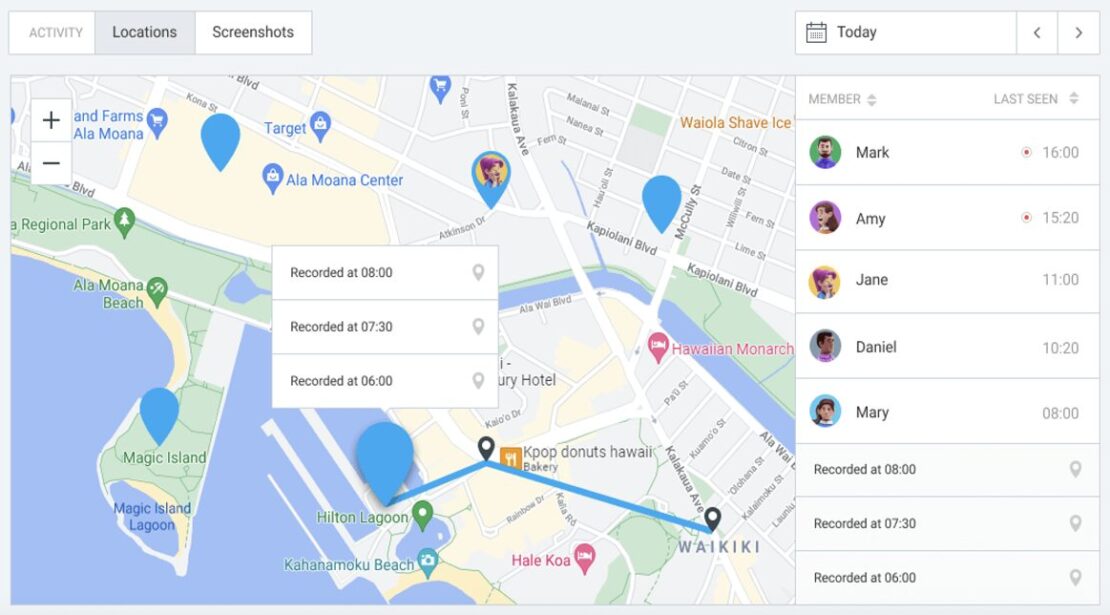
The location feature is particularly helpful for field workers in industries such as construction, landscaping, and healthcare.
By analyzing clocking data, HR and operations managers can:
- Spot potential issues like employee disengagement,
- Prevent excessive overtime for reduced overtime costs,
- Optimize employee scheduling, and
- Ensure fair employee compensation, leading to higher employee satisfaction and retention.
💡 CLOCKIFY PRO TIP
Consider a few tried-and-tested methods to keep tabs on your team’s productivity:
In the next section, we’ll explain different types of clock-in clock-out systems to help you choose the one that fits your and your team’s needs perfectly.
Types of clock-in clock-out systems
Some of the most commonly used time and attendance systems include:
- Paper timesheets — physical copies of time entries entered by hand, which are simple to use but time-consuming and prone to human error.
- Clock-in clock-out machines — devices that vary from traditional punch card time clock systems to sophisticated biometric time clocks, which are quick to use but can easily malfunction.
- Software — modern systems in the form of computer programs that can be installed on any device or accessed through a browser.
One study found that 38% of US employees rely on manual systems (e.g., paper timesheets and time cards) for clocking in at work. This form of employee time tracking is outdated and limited, as it’s:
- Slow,
- Prone to errors, and
- Unable to measure productivity.
On the other hand, software-based systems are more versatile and can take many shapes, like:
- Time kiosks,
- Timer apps,
- Online timesheets, and
- Auto trackers.
A major perk of having employees clock in and out using software is that it gives you precise data you can analyze later.
Track employee time efficiently
To learn more about these software-based clock-in clock-out solutions — read on.
Clock-in/out solution #1: Kiosk
The question as old as time — or at least as old as the digital time clock — how to clock in at work without too much friction? One of the simplest ways is to use a time clock kiosk.
A time clock kiosk allows employees to clock in and out from a shared device by entering their PIN code. This device can be any gadget with an internet connection, like a tablet or smartphone. The PIN code serves as one layer of security to avoid buddy punching.
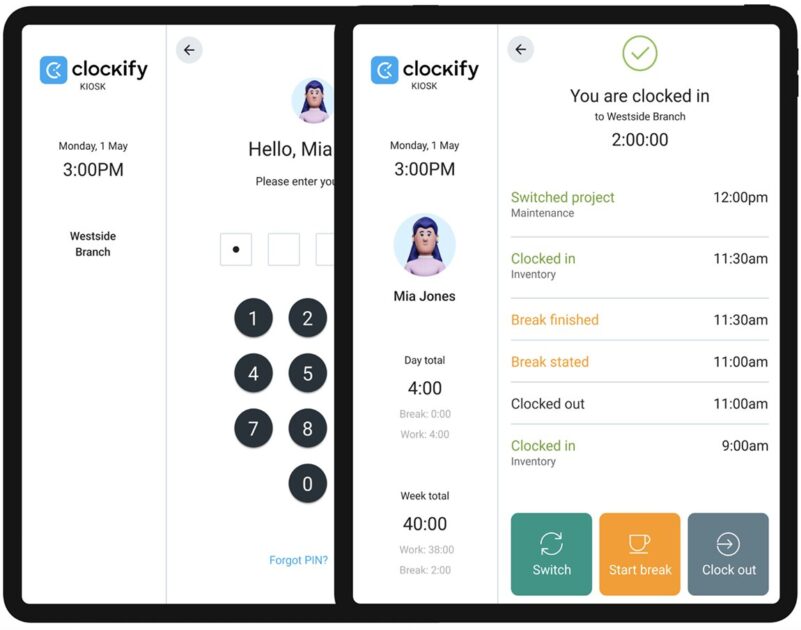
Besides clocking in and out, Clockify’s kiosk allows employees to:
- Track breaks for precise time records,
- See all their activity, and
- Switch between tasks and projects they’re tracking time for, streamlining workflows.
Managers can use Clockify’s team dashboard to see who’s currently clocked in, what they’re working on, or their last activity. This enables quick activity and attendance checking.
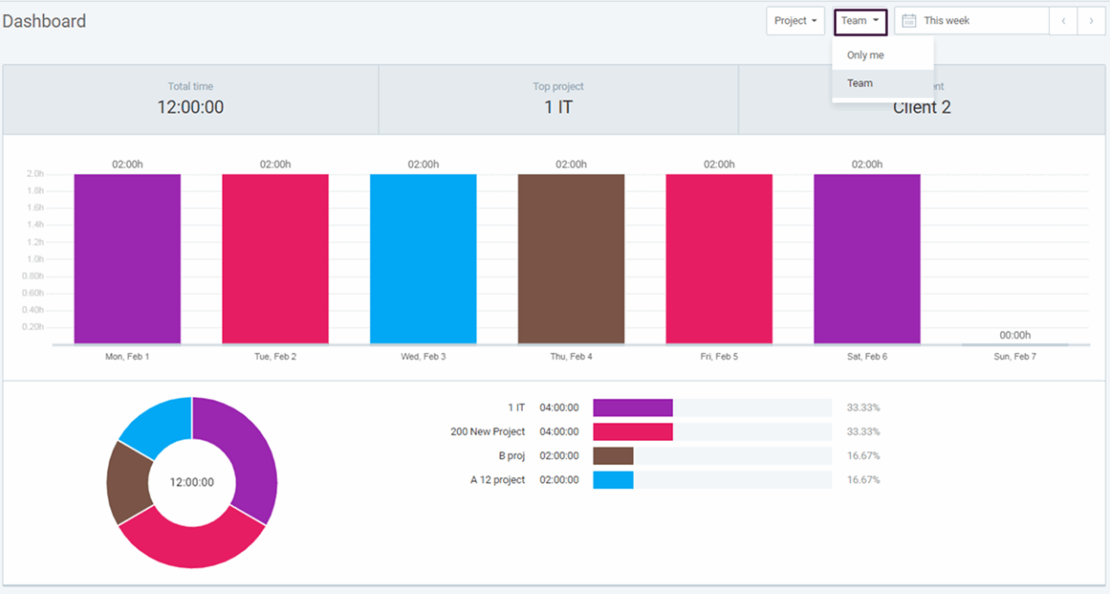
All in all, a kiosk is suitable for both large and small businesses with on-site workers that want a reliable and cost-effective solution for centralized timekeeping.
💡 CLOCKIFY PRO TIP
Learn about the pitfalls of working off-the-clock with our in-depth guide:
Clock-in/out solution #2: Timer app
Aside from a kiosk, you can use a timer app as your employee time tracking system. A timer app runs in the background, allowing users to track the time spent working on specific tasks and projects.
If your employees start the timer immediately upon arriving at work and stop it once their workday is over, you’ll have data that accurately represents hours worked.
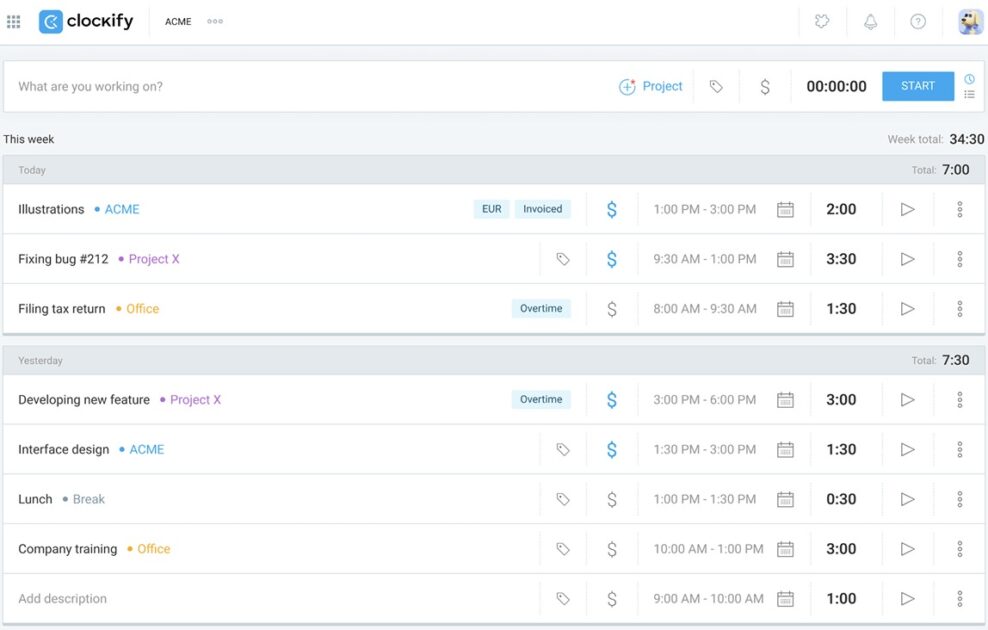
What’s more, timer apps like Clockify even work offline. This ensures consistent employee time tracking, especially for field staff or employees with unreliable internet access.
Additionally, an employee can edit their time entry if it doesn’t accurately reflect the actual work they completed during the specified period. That way, everyone is in the loop about the time and effort put into tasks — transparency at its best.
In cases where some employees have committed time theft, employers may want to prevent them from editing or adding their time entries manually. That’s where options like force timer come in.

When the force timer is enabled in Clockify, users are limited to using the timer only — all other options for tracking time, except for the auto tracker, become unavailable.
Therefore, this clock-in/out system is ideal for HR or operations managers who need precise data regarding when and for how long their employees are working.
Clock-in/out solution #3: Timesheets
If you don’t need to track productivity in real time, your employees can simply fill their digital timesheets at the end of the day or week, detailing what they worked on and for how long. Workers can do this in a timesheet app.
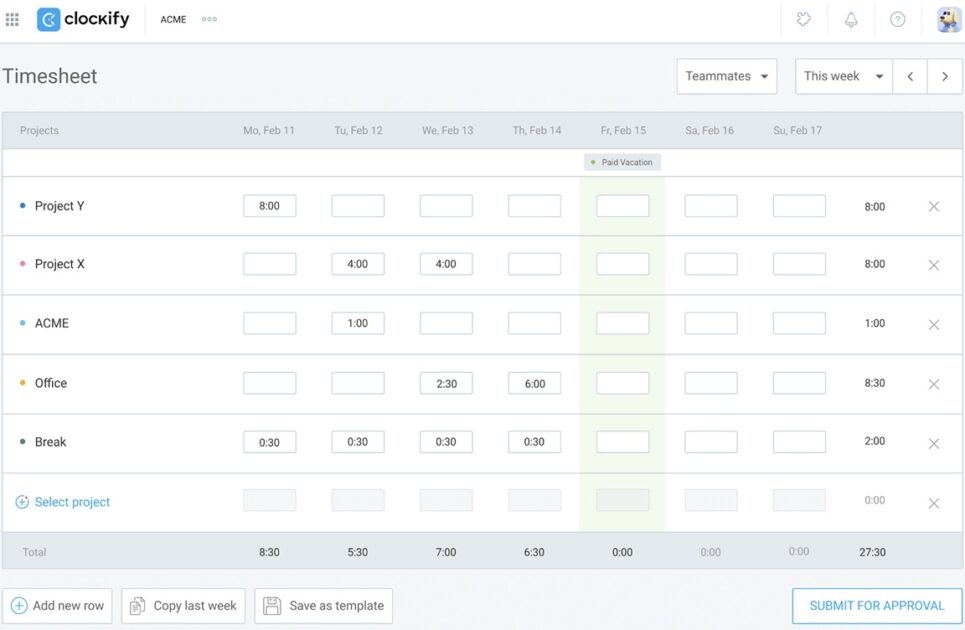
Although not as precise as the timer method, this technique is the easiest for employees to add to their everyday workflow.
You can even schedule automatic timesheet reminders for your employees if they forget to log their time. This way, you don’t have to chase employees for timesheets — the system handles reminders, saving you valuable time.
Plus, managers get to approve timesheets before submitting them to payroll, allowing for smoother payroll processing.
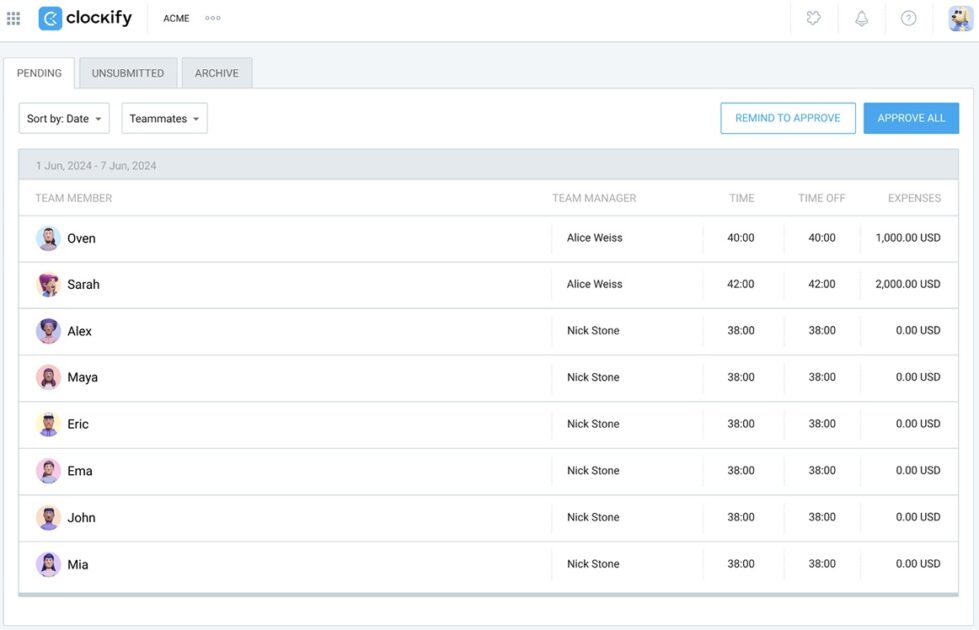
Apps like Clockify allow users to populate their new timesheets with the most common work activities from the past or copy time and activities from previous timesheets. This reduces manual effort and speeds up the timesheet submission process.
Essentially, timesheets are useful for all sorts of businesses as they provide clear and easily accessible data for payroll and compliance purposes.
💡 CLOCKIFY PRO TIP
Scared you’ll make errors while filling out a timesheet for payroll purposes? We’re all human — but read our guide on how to minimize mistakes when creating or editing timesheets:
Clock-in/out solution #4: Auto tracker
If you like the idea of a timer, but employees find it a hassle, they can turn on the automatic tracker and add their time at the end of the day based on the recorded data.
The auto tracker keeps a list of all apps being used, which users can then easily convert to time entries.
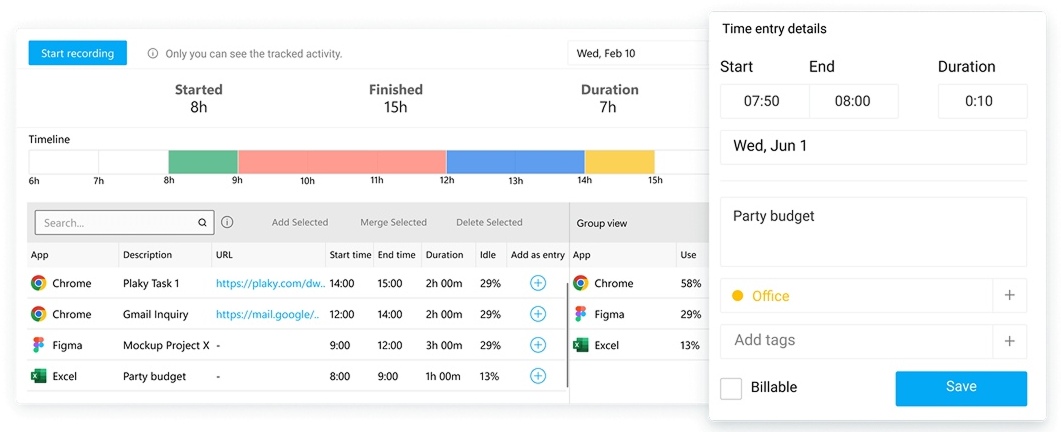
This clock-in/out solution is useful when you need your employees to keep activity logs at work rather than just enter their start and end times. Thus, they can provide detailed information about their workday without having to spend too much time jotting everything down.
FAQs about clock-in clock-out systems
In this section, we’ll answer some of the frequently asked questions about employee time and attendance systems.
How to use the clock-in machine at work?
To clock in via the punch card time clock system, employees insert a paper time card into a designated slot on the machine, which stamps the date and time of arrival onto the card. When they want to clock out, they repeat the process (the machine will then record their departure time).
To clock in and out using a biometric fingerprint clocking-in machine, employees place their finger on the fingerprint scanner to record their attendance.
As an employee scans their fingerprint, the system compares it to the pre-registered template for identification. If the scan matches, the system records their arrival or departure time.
💡 CLOCKIFY PRO TIP
To learn more about the history of timekeeping — from ancient shadow clocks to modern timekeeping systems, check out the blog post below:
How to clock in and out using Workday?
Workday allows users to log their work time from web browsers or mobile devices. To clock in via Workday’s mobile app, employees need to:
- Log in to their account,
- Click on the Check in button,
- Specify details like time type (e.g., regular pay), and
- Click OK to finalize their check-in.
To clock out for the end of their shift, employees need to click the Check out button, leave a comment in the appropriate section (optional), and click Done.
The clock-in/out process may differ depending on how the company sets the app (instead of seeing the Check in button as soon as they log in, employees may have to access the Time Tracking section and log their time from there).
Get a simple Workday alternative
How to clock in and out on Workforce?
To clock in using the Workforce mobile app, employees need to:
- Log in to their account,
- Click the Clock in button,
- Select a team (optional), and
- Click Clock in to confirm.
To check out, they need to click the Clock out button, select a team (optional), and confirm the action by clicking Clock out.
Note that employees may be required to grant location and camera permissions to the app to be able to clock in.
💡 CLOCKIFY PRO TIP
Make headway on how you clock in and out at work with the best apps on the market, and read our reviews for the best clock-in/out systems and best time tracking apps for 2025:
How do you remind employees to clock in and out?
To remind on-site employees to clock in and out, place a physical reminder (e.g., a large, eye-catching sign) near a time clock station.
If you also have remote or field workers, you can use digital reminders, such as scheduled email or text messages. You can utilize Google Calendar to schedule recurring events and send reminders to your employees to clock in and out (e.g., 10 minutes before their shift starts and ends).
Alternatively, you can encourage employees to set alarms on their phones to make sure they don’t forget to check in and out of work.
Use Clockify to check and track attendance
The best way to set up a punch-in punch-out system depends on your business needs and your employees.
To reap all the benefits of a well-structured clock-in clock-out system, give Clockify a try. It comes with all the above-mentioned options — kiosk, timesheets, timer, and auto tracker.
Setting up a clock-in kiosk on your tablet is the best option if you don’t want to bother people with installing an app.
In fact, a clock-in kiosk is by far the most convenient option for on-site workers since it allows them to log their working hours from a single device.
Still, suppose people come to the workplace every day and perform job duties at their computers. In this case, you can invite them as users in Clockify, and they can personally log their hours at the end of the day by:
- Filling their weekly timesheets, or
- Creating time cards with start/end times.
All in all, Clockify is a feature-rich platform that caters to different needs in terms of tracking employee attendance.
Also, you’ll be happy to know that Clockify offers free, human customer support available 24/7 (including holidays) to answer any of your questions or provide guidance.
With many useful features, you can select the plan that best fits your workflow, and track attendance in your company’s offices, in the field, or from your home office.
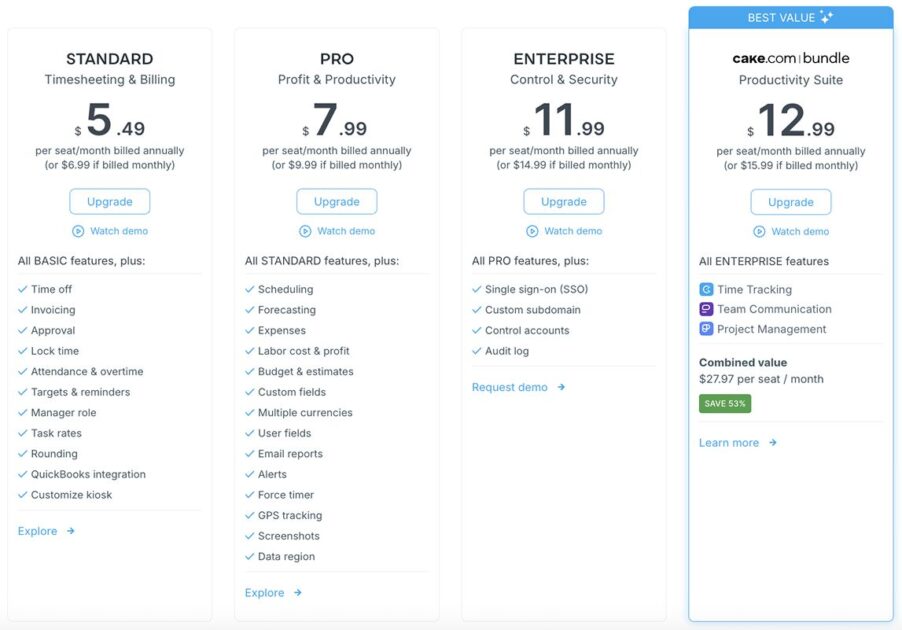
This way, you’ll single out unjustified absences and find ways to increase future attendance.
Turn to tried-and-tested software to solve your attendance problems.
